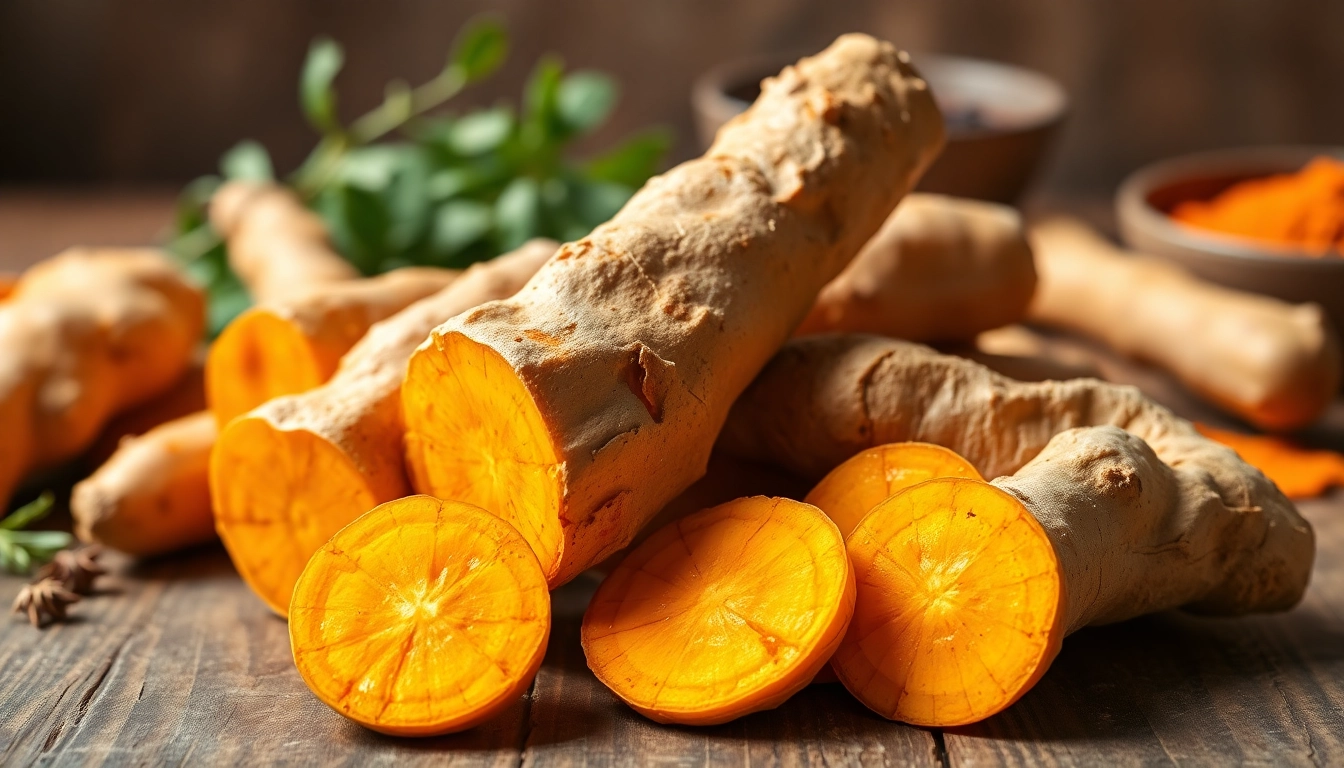Introduction to Turmeric Root
Turmeric root, scientifically known as Curcuma longa, is increasingly recognized not only for its vibrant yellow color and culinary appeal but also for its wealth of health benefits. This spice comes from the rhizome (root) of a native Asian plant and has been an integral part of cooking and traditional medicinal practices for centuries. Today, turmeric’s reputation is bolstered by a growing body of research that supports its potential health advantages, positioning it at the forefront of health and wellness trends. To dive deeper into this fascinating ingredient, consider exploring this Turmeric Root.
Understanding Turmeric Root’s Origins
Turmeric is derived from the rhizome of the Curcuma longa plant, which is primarily cultivated in India, China, and Southeast Asia. The plant thrives in tropical climates and requires rich, well-drained soil to flourish. After about 7-10 months of growth, the turmeric roots are harvested, boiled, and then dried to produce the vivid orange-yellow spice commonly used in kitchens worldwide. More than just a culinary spice, turmeric has deep cultural significance in many Asian communities, where it plays a crucial role in ceremonial practices and traditional medicine.
Significance in Culinary Traditions
In culinary traditions, especially in South Asian cuisines, turmeric is a foundational spice. Its earthy, slightly bitter flavor enhances rice dishes, curries, and stews. Turmeric’s vibrant color also serves a visual purpose, making dishes more appealing. In addition to its flavor profile, turmeric is often paired with black pepper, which increases the bioavailability of its key active ingredient, curcumin. Recipes often include turmeric in various formats — whether fresh, dried, or ground — showcasing its versatility across different cultures, from Indian curries to Middle Eastern stews.
The Rise of Turmeric in Health and Wellness
In recent years, turmeric has gained popularity as a health supplement. The medicinal properties attributed to curcumin, its active compound, have sparked significant interest among researchers, health enthusiasts, and the general population. With studies revealing potential anti-inflammatory and antioxidant effects, turmeric is now often recommended as a natural remedy for a variety of ailments, contributing to its status as a superfood.
Health Benefits of Turmeric Root
Anti-inflammatory Properties of Turmeric Root
One of the most studied aspects of turmeric root is its anti-inflammatory properties. Chronic inflammation is linked to numerous diseases, including heart disease, cancer, and arthritis. Curcumin targets multiple inflammatory pathways, helping to reduce inflammation in the body. Research suggests that regular consumption of turmeric can help alleviate symptoms for those suffering from inflammatory conditions, enhancing overall health and well-being.
Antioxidant Effects and Nutritional Value
Turmeric is rich in antioxidants, which are crucial for combating oxidative stress in the body. Free radicals damage cells and contribute to chronic diseases and aging. The antioxidants present in turmeric, particularly curcumin, have been shown to neutralize free radicals and stimulate the body’s antioxidant defenses. Additionally, turmeric contains essential minerals such as iron, potassium, and manganese, contributing to its overall nutritional value.
Turmeric Root and Digestive Health
Turmeric root is often praised for its positive effects on digestive health. Its anti-inflammatory properties can soothe the digestive tract, while its active compounds help improve gut health by promoting the production of bile, which aids in fat digestion. Many cultures use turmeric as a digestive aid, incorporating it into meals to alleviate bloating, gas, and other digestive discomforts.
Using Turmeric Root in Cooking
Incorporating Fresh Turmeric Root into Recipes
Fresh turmeric root can be used in a variety of culinary applications. It can be grated into smoothies, steeped in teas for an invigorating drink, or included in spice blends for cooking. The warmth of turmeric pairs well with many vegetables, making it a perfect ingredient in stir-fries, soups, and marinades. For those not accustomed to its flavor, starting with small amounts in familiar dishes can help incorporate it into the daily diet seamlessly.
How to Prepare and Store Turmeric Root
Preparation of fresh turmeric root is straightforward: peel the skin off using a vegetable peeler, and then either chop or grate it as needed. Fresh turmeric should be stored in the refrigerator, wrapped in paper towels and placed in an airtight container to maintain its freshness. Dried turmeric powder, on the other hand, should be kept in a cool, dark, and dry place to prevent it from losing flavor and potency.
Pairing Turmeric Root with Other Ingredients
To maximize the health benefits of turmeric, it is often paired with black pepper, which enhances the absorption of curcumin. Other complementary ingredients include healthy fats like olive oil or coconut oil and spicy elements like ginger or garlic. Incorporating turmeric into dishes alongside these ingredients not only boosts flavor but also amplifies its health-promoting properties.
Turmeric Root in Traditional Medicine
Historical Uses of Turmeric in Ayurveda
In traditional systems of medicine such as Ayurveda, turmeric has been used for thousands of years to treat various ailments ranging from skin conditions to digestive issues. Ayurvedic practitioners value turmeric for its balancing properties, helping to harmonize the body’s doshas (energies). It is often recommended to enhance immunity, reduce inflammation, and improve skin complexion.
Current Research on Turmeric Root’s Medicinal Benefits
Modern research continues to substantiate many traditional uses of turmeric. Studies have indicated that curcumin may play a role in reducing the risk of chronic diseases, improving brain function, and even exhibiting anticancer properties. However, it is important to note that while turmeric may have medicinal properties, it should not replace conventional medicine for serious health conditions but rather complement a holistic approach to health and wellness.
Safety and Side Effects of Turmeric Root
While turmeric is considered safe for most people when consumed in culinary amounts, excessive intake, especially in supplement form, may cause side effects such as stomach upset, nausea, or diarrhea. Additionally, individuals taking blood-thinning medications should exercise caution, as turmeric can interact with these drugs. It is always advisable to consult a healthcare professional before incorporating significant amounts of turmeric or curcumin supplements into the diet.
Where to Buy and How to Choose Turmeric Root
Buying Fresh vs. Dried Turmeric Root
When purchasing turmeric, consumers have the option of buying fresh or dried roots. Fresh turmeric is often found in grocery stores’ produce sections, while dried turmeric can be easily sourced from spice aisles. When selecting turmeric, whether fresh or dried, opt for roots that are firm, smooth, and free from blemishes. For dried turmeric powder, look for organic options when possible, as they are less likely to contain additives.
Brands and Quality Indicators
Several reputable brands offer high-quality turmeric products. Look for those that provide third-party testing for purity and potency. Organic certification can also be a good indicator of quality, suggesting that the product is cultivated without synthetic pesticides or fertilizers. Additionally, reading customer reviews can provide insights into the effectiveness and taste of the turmeric products you are considering.
Shopping Tips for Optimal Health Benefits
When shopping for turmeric, consider the following tips to maximize health benefits:
- Always choose organic turmeric when possible, to avoid contaminants.
- Purchase turmeric from reputable suppliers to ensure product quality.
- Check for freshness; more vibrant color usually indicates fresher product.
- Store turmeric properly to prevent spoilage and loss of potency.
- Consider your planned uses (cooking, medicinal) to choose the most suitable form (fresh or dried).


